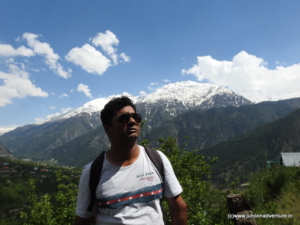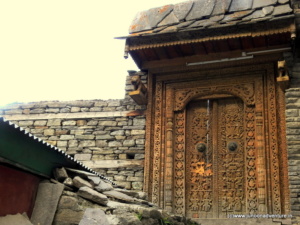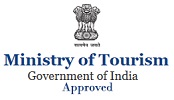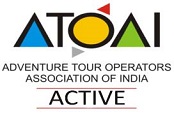Sangla… A place that, for most travelers, just gets a bit of touch-and-go time as they make your their towards Chitkul, the holy grail for all the road trippers out there. But if you have knack for exploration and aren’t averse to a bit of sweat and strain, Sangla has more than enough surprises to keep you hooked for at least a few days. For those on a Spiti Road Trip, Sangla becomes the first window into the transcendent Kinnauri culture and way of life. And for us Junoonis, our second day in this wonderful village brought us face to face with the tall and tumultuous history of the land, enshrined inside the obscure and majestic Kamru Fort.
Now you must know that it is pretty easy to miss this place entirely when you are visiting Sangla. First, the fort isn’t advertised all that well in the village as a prominent place to see in Kamru. No big and flashy road signs point to the fort being ‘that way’. Not much data is available about the structure on the internet either – just a few lines of obscure factoids buried under heaps of praise for Chitkul. Then, there is the fact that you almost cannot see the structure from the main village road in Sangla. And to top it all, you have to brave a 30 minute steep uphill climb to reach the place – a big deterrent for most road trippers who aren’t all that interested in sweating it out and exploring a place on foot. All in all, if you don’t have prior information about the existence of this place, chances are you will pass it by, having no idea of all the surprises that it holds.
 Wondering how we happened to chance upon the place? As usual – Yog Sir’s itch to explore every single pathway in a place… on foot. (*followed by one of my signature long sighs of resigned acceptance*)
Wondering how we happened to chance upon the place? As usual – Yog Sir’s itch to explore every single pathway in a place… on foot. (*followed by one of my signature long sighs of resigned acceptance*)
So our day began with that cheeky glint in his eye (one that lets us know we are in for a LONG day ahead) as Mr. Sudama shared all the info he had gathered from the locals – there is a Fort near Sangla, many centuries old, a stronghold of Bushahr kings and, the cherry on the cake, unknown to most travellers. The route to Kamru Village cuts off at the bridge that you cross while entering Sangla from Rakchham side. As is the case with almost all villages in Kinnaur, a colourful gate marks your arrival into Kamru – a small and everyday settlement resting on a steep hillside. Kinnauri homes stand cheek by jowl along the stairs that rise further and further up the village path which is more or less empty, aside from a few local villagers making their way down towards the Sangla-Chitkul highway where they would catch a ride and head off to work. That’s right – no tourists. And, surprisingly, no fort either.
One would imagine that if a fortified palace of any kind belonging to Himalayan Royalty was standing here by any chance, there would be some tell-tale signs of its existence. A minaret, a fort wall, some sort of signage that points to a prominent piece of history hiding behind these gabled roofs. But no – what lay ahead of us was just a plain old village path that was winding higher and higher, increasing my misgivings as well as the pace of my breathing. And just as we were about to call Mr. Dutt out on what may have been a foolhardy adventure, the ground levelled out and we saw it –
No, not the fort – that was still far away and out of sight. But the temple of Kamru’s Devta Sahab – Badri Vishal Ji or Badri Narayan Ji.
From our previous forays into the village, we now knew that just about every village in Kinnaur will have its local presiding deity – the Devta Sahab who rules over the land, takes decisions, decides about social calendars and solves disputes for the villagers. Village Kamru and Palika Kamru (a smaller hamlet located above Kamru) were under the protection of Badri Narayan Ji, believed to be the brother of Badrinath Ji in Uttarakhand. Anthropologists mark the emergence of the ‘Narayan clan’ of deities in Kinnaur to indicate the influence of Hinduism as it began to mix with the indigenous culture of Kinnaur. The beliefs of Kamru are no different than those of any other village in the region but the religious symbolism on the temple and the imagery used to describe the deity is largely Hindu in origin. Devta sahab actually enjoys a seat of honour in the court of Badrinath Ji and even visits his brother from time to time. He commands much respect and awe from his subjects, who believe that his protection is the reason why the hills have stopped flooding, the lands have stopped sliding and their Apple plantations have started to grow.
And so with the blessings of Badri Vishal Ji and renewed energy stemming from the excitement of finding an offbeat place in Kamru, we began climbing again. And then, out of nowhere, we were there!
…and the bubble just deflated. This was a fort? No… surely the person who named it must be mistaken. Forts are sprawling structures of stone, massive courtyards with minarets and domes, long, flowing walls that snake out from the central edifice, protecting everything within. Images of Chittorh, Jaipur, Mandu and so on began swirling through my brain as the tower that stood before me stood tall and proud – nothing like anything you would expect from a ‘Fort’.
Forts of Kinnaur are an acquired taste, maybe a bit like green tea – a refreshing drink that never sits well with traditional chai lovers on the first go. But when you get past the initial hit-back of your ‘typical-patterns’ loving brain, these structures kinda grow on you! As they did for us…
The lofty tower that makes up Kamru Fort stands imposingly against the backdrop of the mighty Kinnaur-Kailash peak. The five storey-ed building is beautifully dressed of stone, bound at small intervals with wooden rafters and topped with a gabled roof and a ridgepole. As per the locals, the fort houses all the 36 crore Devis and Devtas of Hinduism in one monumentally pious structure. The fort’s entry way has two gates – one made of carved wood and the other with ornate metal carvings. And to enter the courtyard, you need to don a Kinnauri Topi (cap) and Kamarbandh (belt), both available at the gate. Of course, as with all Himalayan places of worship, all items of leather like shoes, belts and wallets are to be left outside.
So, all set and ready, we climbed the last few stairs, past the gates and into the temple courtyard, only to find the biggest surprise of them all –
That’s right – the revered, awed and often feared form of Devi from the North East, better known as the Menstruating Goddess from Assam, has her second seat here. Kamru’s history talks of the Bushahr Kings of old constructing this fort as their stronghold in Kinnaur and bringing Kamakhya Devi Ji or Kamru Kamakshi Devi Ji here, all the way from Kamrup in Assam to bless the village. Locals share tales of how the power of Devi ji is so great that no king in the land has ever been able to rule without her blessing. In fact, the Kings of Bushahr made Kamru Fort as the place for their official coronation (rajya-abhishek) ceremony and every ruler from Raja Kehri Singh to Raja Padam Singh were crowned here. And, as the locals share, since Raja Virbhadra Singh (current ruler) and his son didn’t have their coronation at Kamru, under Kamakshi Devi’s influence, their reign on the kingdom has all but faded out of existence.
The history of Kamru fort, the culture of the village, the beliefs of the locals and their amazing tales – so many reasons exist for a traveller to plan a heritage walk around Kamru Fort. But as we descended the stairs back onto the highway, we could see all those vehicles zooming past, not having the slightest of ideas that such an amazing piece of history is lying hidden, just a half an hour’s worth climb away!
If you wish to experience these unexplored places in Kamru and witness the heritage of Himachal Pradesh first hand, call +91-9479824975 for Kamru fort hotels and more.
 JT2 Road Trip to Spiti Valley
JT2 Road Trip to Spiti Valley
13th to 23rd September




